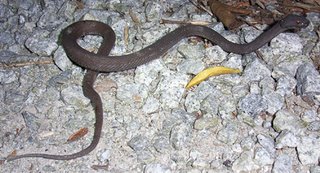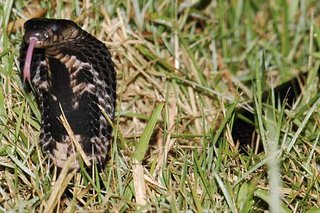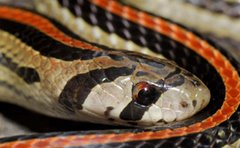 I cannot believe my eyes when a Gold-ringed Cat Snake (Boiga dendrophila) swam towards me, Chan Kwok Wai and Lim Swee Cheng. We were standing besides a small stream in Upper Peirce Reservoir on 24 October 2006 at 8.30 pm. It was a large specimen, approximately 2 m in total length and 2.5 kg in body weight. When mature, the Gold-ringed Cat Snake reaches a length of about 2.5 m (Lim & Lee, 1989; Lim & Lim, 1992; Cox et al., 1998). This arboreal species is also commonly known as the Mangrove Snake, but seems to be rarely found in local mangroves.
I cannot believe my eyes when a Gold-ringed Cat Snake (Boiga dendrophila) swam towards me, Chan Kwok Wai and Lim Swee Cheng. We were standing besides a small stream in Upper Peirce Reservoir on 24 October 2006 at 8.30 pm. It was a large specimen, approximately 2 m in total length and 2.5 kg in body weight. When mature, the Gold-ringed Cat Snake reaches a length of about 2.5 m (Lim & Lee, 1989; Lim & Lim, 1992; Cox et al., 1998). This arboreal species is also commonly known as the Mangrove Snake, but seems to be rarely found in local mangroves. This mildly-venomous but docile snake is popularly used by local snake charmers (Lim & Lim, 1992) and "gor yok" peddlers. It is nocturnal and is known to hunt for small vertebrates such as birds, eggs, lizards and rodents (Lim & Lee, 1989; Lim & Lim, 1992). About 4 to 15 eggs are laid per clutch, and the incubation period is about 3 months (Lim & Lee, 1989; Cox et al., 1998). Hatchlings are about 40 cm and resemble adults (Lim & Lee, 1989; Cox et al., 1998).
Gold-ringed Cat Snake occurs in southern Thailand, Peninsular Malaysia, Singapore and part of Sumatra (Lim & Lee, 1989; Cox et al., 1998).
* Photograph from Mr Lim Swee Cheng

* Desktop Wallpaper from Mr Chan Kwok Wai
REFERENCES
Cox, M. J., van Dijk, P. P., Nabhitabhata, J. & Thirakhupt, K., 1998. A photographic guide to snakes and other reptiles of Peninsula Malaysia, Singapore and Thailand. New Holland Publishers (UK) Ltd, p. 75.
Lim, F. L. K. & Lee, M. T. M., 1989. Fascinating Snakes of Southeast Asia – an Introduction. Tropical Press, Kuala Lumpur, p. 76.
Lim, F. L. K. & Lee, M. T. M., 1989. Fascinating Snakes of Southeast Asia – an Introduction. Tropical Press, Kuala Lumpur, p. 76.
Lim, K. K. P. & Lim, F. L. K., 1992. A Guide To The Amphibians & Reptiles Of Singapore. Singapore Science Centre, p. 73.






















